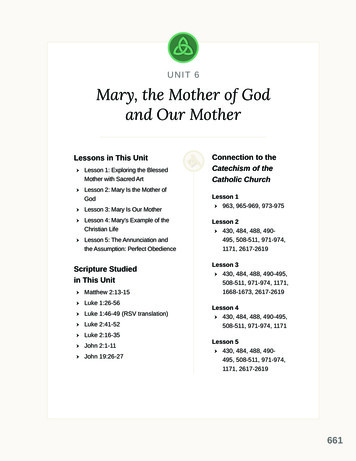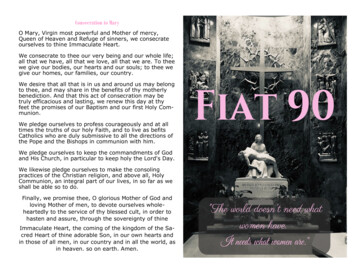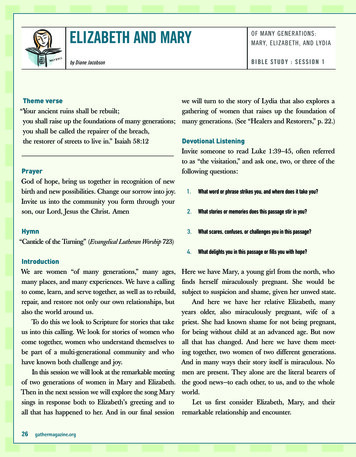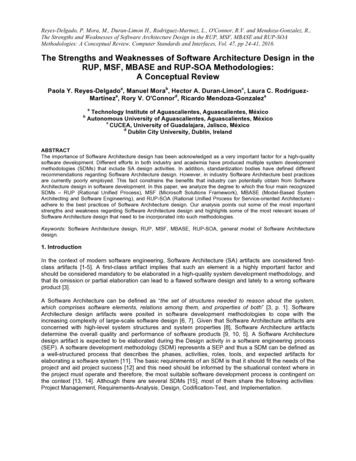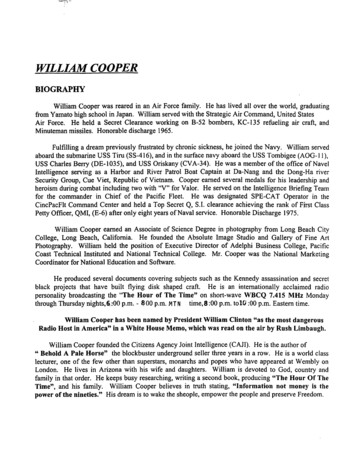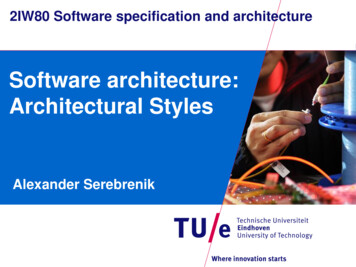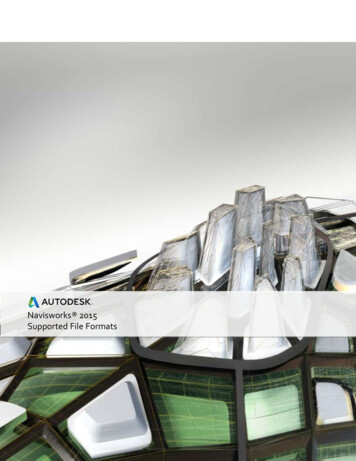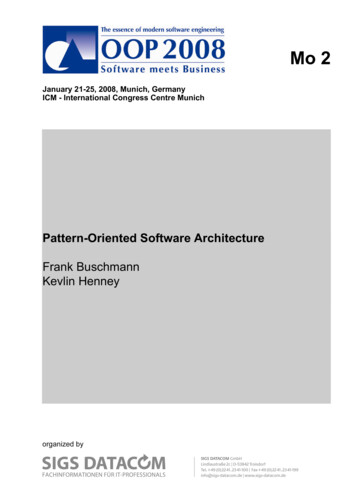
Transcription
Software Architecture
Software architecture The design process for identifying the subsystems making up a system and theframework for sub-system control andcommunication is architectural design The output of this design process is adescription of the software architecture
Architectural design An early stage of the system design process Represents the link between specification anddesign processes Often carried out in parallel with somespecification activities It involves identifying major systemcomponents and their communications
Advantages Stakeholder communication– Architecture may be used as a focus of discussionby system stakeholders System analysis– Means that analysis of whether the system canmeet its non-functional requirements is possible Large-scale reuse– The architecture may be reusable across a range ofsystems
Architectural design decisions Is there a generic application architecture that canbe used? (How) will the system be distributed? How will the system be decomposed into modules? How will the architectural design be evaluated? How should the architecture be documented?
Architecture reuse Systems in the same domain often have similararchitectures that reflect domain concepts Application product lines are built around acore architecture with variants that satisfyparticular customer requirements Examples?
Architectural styles In order to create more complex software it isnecessary to compose programming patterns For this purpose, it has been useful to induct a set ofpatterns known as “architectural styles” Examples:– Pipe and filter– Event based/event driven– Layered– Repository– Object-oriented– Model-view-controller
Software Architectural Styles Constituent parts:– Components– Connectors– Interfaces– Configurations
Example
What are components? Components are the loci of computation– Components “do the work” in the architecture May be coarse-grained (an editor) or fine grained (a clock emitting ticks)
What are connectors? Connectors are the loci of communication– Connectors facilitate communication amongcomponents May be fairly simple (Broadcast Bus) or complicated (Middleware-enabled) May be implicit (events) or explicit (procedure calls, ORBs, explicitcommunications bus)
What are interfaces? Interfaces are the connection points oncomponents and connectors– They define where data may flow in and out of thecomponents/connectors May be loosely specified (events go in, events go out) or highly specified
What are configurations? Configurations are arrangements ofcomponents and connectors to form anarchitecture
Common architectural styles Pipe-and-filter Repositories Event based systems (implicit invocation) Model-View-Controller Layered systems Object-oriented architectures
Pipe-and-filterSource: Adapted from Shaw & Garlan 1996, pipepipefilterfilterpipepipe Data flow styles: Filters transform input into output– components: filters -computational i.e. retain minimal state– connectors: data streams– control: data flow between components– Topologies: arbitrary, acyclic, pipeline (linear) A series of independent, sequential transformations on ordered data. A component has a set of inputs and outputs. A component reads a stream of data and produces a stream of data.
Example: Traditional Compilers
Pipe-and-filter Examples:– UNIX shell commands– Compilers: Lexical Analysis - parsing - semantic analysis - codegeneration– Signal Processing Interesting properties:– filters are independent entities– filters don’t need to know anything about what theyare connected to
Example: Click Network routers are complicated pieces ofcode Eddie Kohler’s idea: Write routers as modularcomponents connected by pipe-and-filter
Pipe-and-filter Advantages– Overall behavior can be understood as a simplecomposition of the behaviors of individual filters– Support reuse Existing filters can be hooked up to form a system– Easy maintenance and enhancement New filters can replace old ones– They support parallel execution– Support specialized analysis, such as throughputand deadlock analysis
Pipe-and-filter Disadvantages– Not good for handling interactive applications Complete transformation of input data to output data– Difficult to maintain correspondences between twoseparate but related streams– Extra overhead to parse and unparse data
RepositoriesSource: Adapted from Shaw & Garlan 1996, p26-7.agentagentagentagent blackboard(shareddata)agentagentRepositories: blackboard or database: Centralized data, usually structured– components: central data store, many computational objects– connectors: computational objects interact with central store directly or viamethod invocation– control: may be external, predetermined or internal– topology: star Maintaining and managing a richly structured body of information Data is long-lived and its integrity is important Data can be manipulated in different ways
Example: Compiler Optimization
Repositories Examples––– databasesmodern compilersprogramming environmentsInteresting properties–can choose where the locus of control is (agents,blackboard, both)–reduce the need to duplicate complex dataDisadvantages–blackboard becomes a bottleneck
Event based (implicit invocation)Source: Adapted from Shaw & Garlan 1996, diumagentlisten foreventagent listen for eventannounce agentevent event based: implicit invocation: Independent reactive objects(or processes)– components: objects that register interest in “events” and objectsthat “signal events”– connectors: automatic method invocation– control: decentralized, de-coupling of sender and receiver– topologies: arbitrary
Event based (implicit invocation) Examples– debugging systems (listen for particular breakpoints)– database management systems (for data integrity checking)– graphical user interfaces Interesting properties– announcers of events don’t need to know who will handle theevent– Supports re-use– Supports evolution of systems (add new agents easily) Disadvantages– Components have no control over ordering of computations– Nor do they know when they are finished– Correctness reasoning is difficult
More Examples Web servers, file servers Embedded Systems– Sensor networks Business processes (Long running transactions)
Model-View-Controller
Example of Model-View-Controller
Layered SystemsSource: Adapted from Shaw & Garlan 1996, p25.application layerusersutilitieskernel Layered system: Independent processes– Components: processes– Connectors: protocols that determine how layersinteract– Topologies: layered
Example: ISO Network Protocol
Layered Systems Examples– Operating Systems– Communication protocols Interesting properties– Support increasing levels of abstraction duringdesign– Support enhancement (add functionality) Change in one layer affects at most two layers– Reuse can define standard layer interfaces interchange implementations of same interface
Layered Systems Disadvantages– May not be able to identify (clean) layers– For performance reasons one layer may want tocommunicate with a non-adjacent layer Especially true in real-time performance critical systems(cross layer design may be more efficient)
Object Oriented ArchitecturesmethodinvocationobjectobjectSource: Adapted from Shaw & Garlan 1996, cationmethodinvocation Objected-oriented styles: data abstraction: Localized statemaintenance (encapsulation)– components: managers– connectors: method invocation– control: decentralized– topologies: arbitrary
Object Oriented Architectures Examples:– abstract data types– object broker systems (e.g. CORBA) Interesting properties– data hiding (internal data representations are notvisible to clients) Can change implementation without affecting clients– can decompose problems into sets of interacting agents Disadvantage– objects must know the identity of objects they wish tointeract with
Summary Architecture is what enables us to “scale up”our software to handle larger applications You must gain the ability to match the rightarchitecture to the right application
Think About How can architectures help reason about nonfunctional requirements?– Safety?– Security?– Dependability?– Performance?– Availability?– Maintainability?–
Examples Performance– Localize critical operations and minimize communications. Uselarge rather than fine-grain components. Security– Use a layered architecture with critical assets in the inner layers Safety– Localise safety-critical features in a small number of subsystems Availability– Include redundant components and mechanisms for faulttolerance Maintainability– Use fine-grain, replaceable components.
Conflicts Using large-grain components improvesperformance but reduces maintainability Introducing redundant data improves availabilitybut makes security/consistency more difficult Localizing safety-related features usually meansmore communication so degraded performance
Distributed Architectures
Distributed systems architectures Client-server architectures– Distributed services which are called on by clients.Servers that provide services are treateddifferently from clients that use services. Distributed object architectures– No distinction between clients and servers. Anyobject on the system may provide and use servicesfrom other objects.
Middleware Software that manages and supports the differentcomponents of a distributed system. In essence, itsits in the middle of the system. Middleware is usually off-the-shelf rather thanspecially written software. Examples– Transaction processing monitors;– Data converters;– Communication controllers.
Multiprocessor architectures Simplest distributed system model. System composed of multiple processes whichmay (but need not) execute on differentprocessors. Architectural model of many large real-timesystems. Distribution of process to processor may bepre-ordered or may be under the control of adispatcher.
Client-server architectures Application modeled as a set of– services provided by servers and– set of clients that use these services– Network for communication Clients know of servers but servers need notknow of clients Clients and servers are logical processes
Client-server characteristics Advantages– Distribution of data is straightforward– Makes effective use of networked systems– Easy to add new servers or upgrade existing servers Disadvantages– No shared data model so sub-systems use different dataorganisation. Data interchange may be inefficient– Redundant management in each server;– No central register of names and services - it may be hard tofind out what servers and services are available
Thin and fat clients Thin-client model– All of the application processing and datamanagement is carried out on the server– Client is responsible for running the presentationsoftware Fat-client model– Server is only responsible for data management– Software on the client implements the applicationlogic and the interactions with the system user
Thin client model Used when legacy systems are migrated toclient server architectures.– Legacy system acts as a server in its own right witha graphical interface implemented on a client. Disadvantage:– places a heavy processing load on both the serverand the network– latency
Fat client model More processing is delegated to the client asthe application processing is locally executed Most suitable for new systems where thecapabilities of the client system are known inadvance More complex than a thin client modelespecially for management. New versions of theapplication have to be installed on all clients.
Layered application architecture Presentation layer– Concerned with presenting the results of a computation tosystem users and with collecting user inputs Application processing layer– Concerned with providing application specific functionalitye.g., in a banking system, banking functions such as openaccount, close account, etc. Data management layer– Concerned with managing the system databases
Three-tier architectures Allows for better performance than a thinclient approach Simpler to manage than a fat-client approach Recall: MVC A more scalable architecture - as demandsincrease, extra servers can be added.
Distributed object architectures There is no distinction in a distributed objectarchitectures between clients and servers. Each distributable entity is an object that providesservices to other objects and receives services fromother objects. Object communication is through a middleware systemcalled an object request broker. However, distributed object architectures are morecomplex to design than C/S systems.
Advantages Can delay decisions on where and how services shouldbe provided New resources to be added to it as required Scaleable Possible to reconfigure the system dynamically withobjects migrating across the network as required
CORBA CORBA is an international standard for an ObjectRequest Broker - middleware to managecommunications between distributed objects Middleware for distributed computing is required at 2levels:– At the logical communication level, the middleware allowsobjects on different computers to exchange data and controlinformation;– At the component level, the middleware provides a basis fordeveloping compatible components. CORBA componentstandards have been defined.
Service-oriented architectures Based around the notion of externallyprovided services (web services) A web service is a standard approach tomaking a reusable component available andaccessible across the web– A tax filing service could provide support for usersto fill in their tax forms and submit these to thetax authorities
Services and distributed objects Provider independence Public advertising of service availability Opportunistic construction of new services throughcomposition (e.g., mashups) Smaller, more compact, loosely coupled applications
Services standards Services are based on agreed, XML-basedstandards so can be provided on any platformand written in any programming language. Key standards– SOAP - Simple Object Access Protocol;– WSDL - Web Services Description Language;– UDDI - Universal Description, Discovery andIntegration.
Automotive systemRoad traffic infoWeatherinfoFacilitiesinfogps coordRoadlocatorgpscoordgps coordMobile Info eivesinformation streamfrom servicesRadioTranslates digitalinfo stream toradio signalTrafficinfoCollates informationService discoveryFinds availableservicescommandgps coordTransmitterSends position andinformation requestto servicesUser interfaceReceives requestfrom userLocatorDiscovers carpositionIn-car software system
Software architecture The design process for identifying the sub-systems making up a system and the framework for sub-system control and . – Object-oriented – Model-view-controller. Software Architectural Styles Cons
